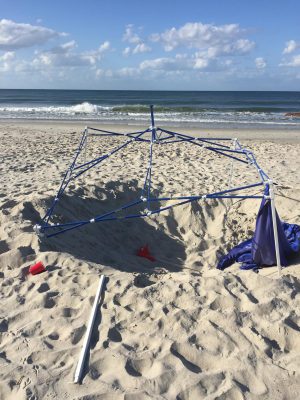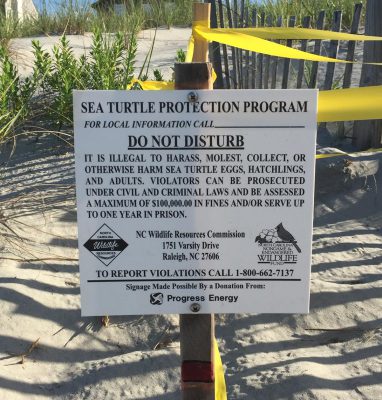
ATLANTIC BEACH – It was a warm summer morning, and Michele Lamping carefully scanned the beach, picking up trash as she went. Amid the litter, footprints and shells scattering the shoreline, she was looking for the distinct tracks of endangered sea turtles, which find their way to beaches along North Carolina’s coast each spring and summer to lay their eggs.
Lamping, 35, is an aquarist at the North Carolina Aquarium at Pine Knoll Shores. She also leads a local effort to find and protect sea turtle nests. As the volunteer coordinator of the Atlantic Beach sea turtle patrol for the last seven years, Lamping has seen firsthand how important volunteers along the state’s coast are to the success of the species.
Supporter Spotlight
“Without our group, we have a whole bunch of turtles that wouldn’t exist,” she said. “Our volunteers are saving thousands of turtles every year.”
The beach and turtles-nesting seasons coincide along the North Carolina coast. During the early mornings and late nights from May to September, volunteers walk stretches of the beach from Currituck to Calabash, meticulously looking for turtle trails that lead to nests. Most belong to loggerheads, but green, Kemps’ Ridley and leatherback sea turtles also nest on the state’s beaches.
The state Wildlife Resources Commission runs the North Carolina Sea Turtle Project, which the commission says on its website would not be possible without volunteers. Participants help find, mark and monitor nests at 25 beaches along the coast and report beached sea turtles and sightings. Volunteers report to the commission, which makes decisions about the turtles’ well-being on land.
Sea turtles that nest in North Carolina are listed as endangered species in part, Lamping said, because many beaches have become dangerous or undesirable places for nesting.
One of the biggest issues is light pollution, she said. The volunteers take measures to block out light during the nesting season, and Lamping has talked to town officials in an attempt to get some of the nearby lights shut off. Too much artificial light, she said, could confuse the baby turtles that follow the light source, usually away from the ocean.
Supporter Spotlight

“Before we did all the efforts that we’re doing, we lost every nest,” she said. “They just all got killed. They all just went backwards in the dunes and just got eaten.”
Trash, debris and holes left on the beach pose a danger to sea turtles, as they can block the path of both mothers and babies trying to get to and from the ocean. Turtles can also ingest the plastic, which has devastating effects.
Volunteers pick up trash during their patrols, and on this particular day, Lamping collected about a grocery bag full of trash. She pointed to a plastic bag laying in the sand.
“Did this family know that they just left that bag on the beach,” she said, “of how many animals it could potentially kill?”
She said two or three years ago, a dead adult female leatherback turtle was found on this stretch of beach that was half her body weight, only 700 pounds. It was discovered that a piece of plastic had lodged in her intestine, essentially starving the turtle for months, or even years.
To keep turtle nesting grounds safe, Lamping has a simple message.
“Go enjoy the beach,” she said, “but leave it in the same condition or better as you found it.”
Each beach’s turtle patrol is run differently. On Atlantic Beach, Lamping breaks the beach into half-mile zones, where volunteers search for tracks for an hour or so in the morning or night, depending on the beach.
The Atlantic Beach patrol has about 20 consistent volunteers and 40 more that volunteer when they are able. Once volunteers find sea turtle tracks, they determine whether the tracks lead to a nest.
Lamping checks on any reported nests and sends off one egg to a lab that records the mother’s genetic marker so scientists can keep tabs on the turtle as it nests throughout its lifetime.
“We know how many times each female’s nesting each season,” she said, “where she’s nesting, how many nests she laid that season and how many years in between nesting seasons she goes.”

The nests are marked with bright ribbons during the 50- or 60-day incubation period, around which time, Lamping organizes a “nest-sitting,” where volunteers keep guard near the nest to make sure nothing obstructs the baby turtle’s trip to the ocean.
Not everyone has been receptive to the volunteers. Lamping said that she used to fill in big holes or leave a note on beach gear left overnight, which can trap turtles, until people started getting mad at her.
“I had people come at me, like yelling, screaming, cussing me out because I was filling in their holes,” she said.
Following incidents like these, Lamping said she approached the town about filling in the holes. She said the city has been receptive and helpful, filling in holes and shutting off lights when they can.
Despite the occasional obstacle, Lamping said she thinks that sea turtles have become spokespersons for ocean conservation, and that they bring people, volunteers and communities together to work towards a healthier environment. She said that by taking care of our beaches for turtles, volunteers also help the birds, fish and other animals that call these habitats home.
“You get people to care about one animal,” she said, “and it really is them caring about all the animals.”







